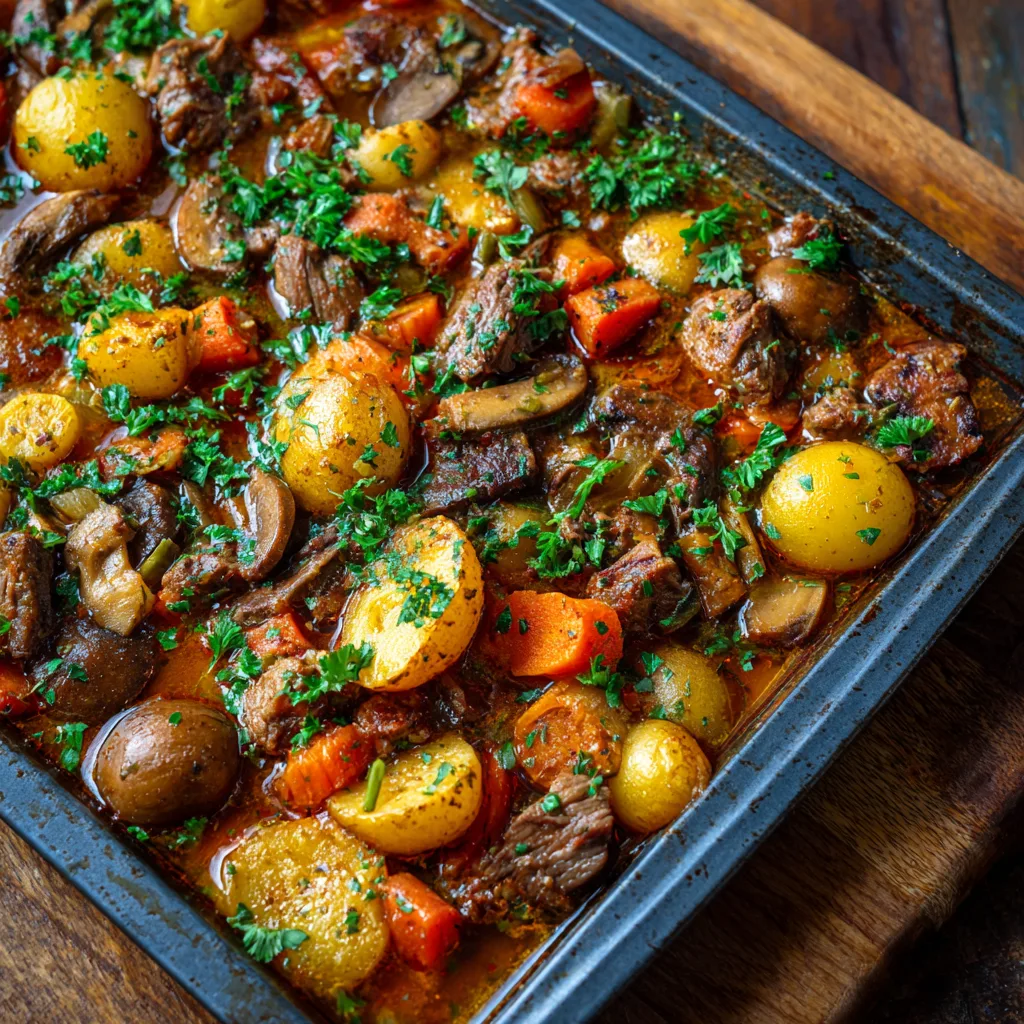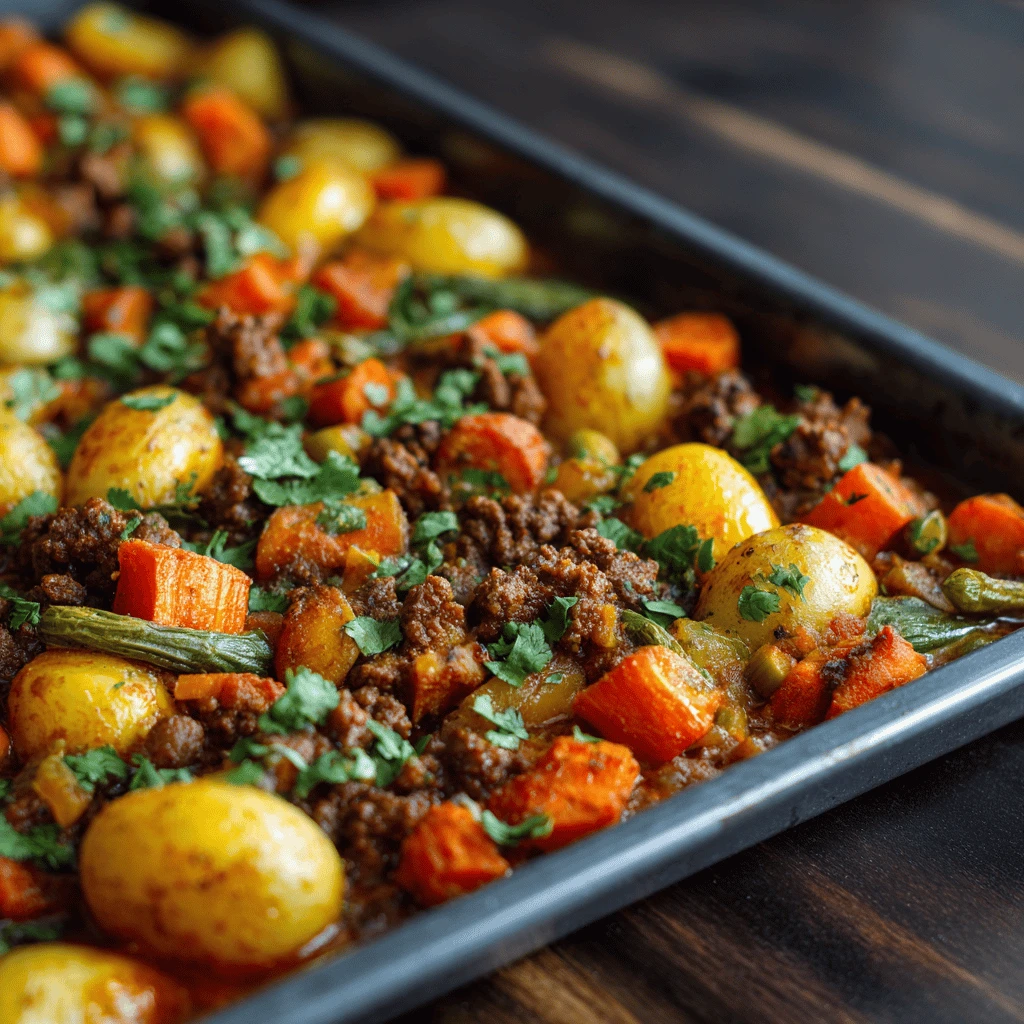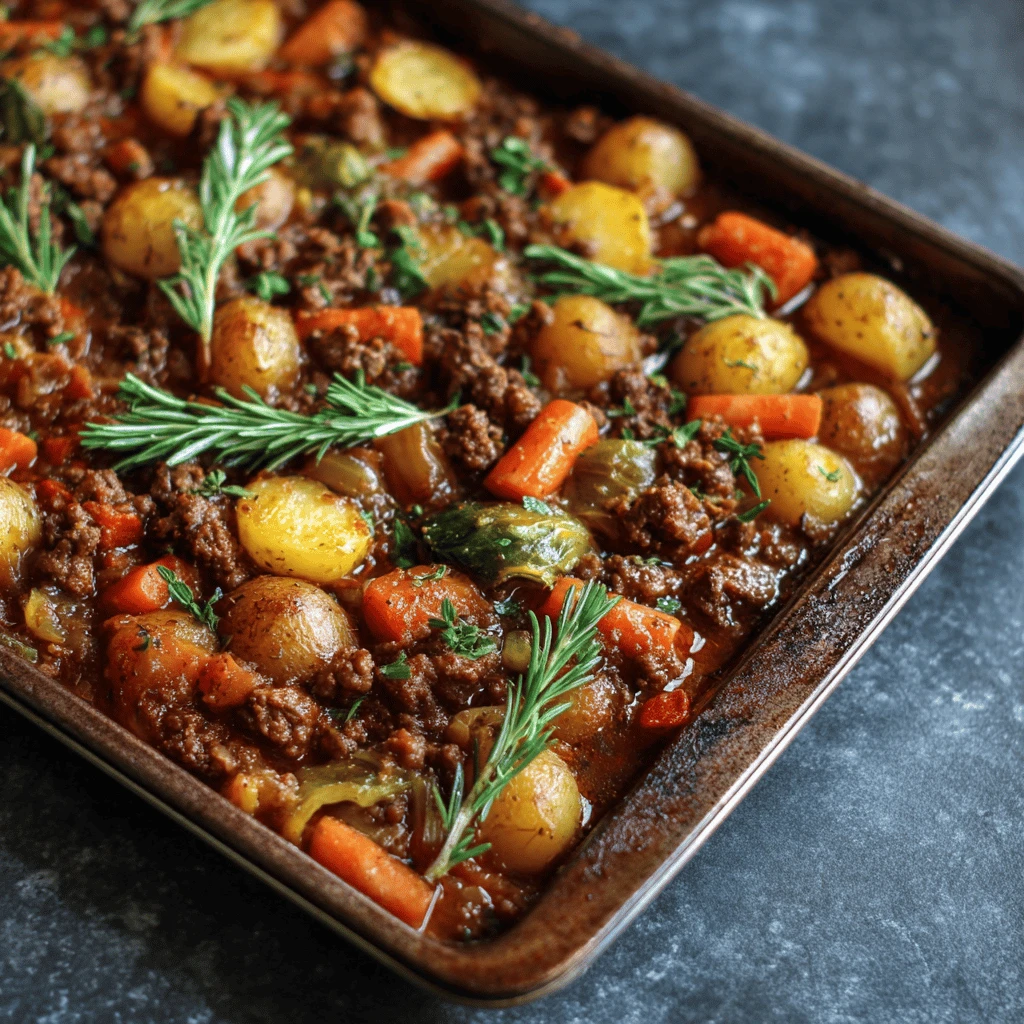Quick Sheet Pan Ground Beef Stew
Sheet pan meals are all the rage, and for good reason. They’re quick, easy, and minimize cleanup. But can you make a hearty stew on a sheet pan? Absolutely! This recipe for Quick Sheet Pan Ground Beef Stew delivers all the comforting flavors of a traditional stew with a fraction of the effort.
Why Sheet Pan Stew is a Game Changer
Traditional beef stew requires simmering on the stovetop for hours to develop its rich flavor. While delicious, it’s not always practical for busy weeknights. Sheet pan stew offers a fantastic alternative:
- Speed: The high heat of the oven allows the vegetables to roast quickly and the ground beef to brown beautifully, significantly reducing cooking time.
- Ease: Simply toss everything on a sheet pan, bake, and enjoy. Minimal active cooking time is required.
- Flavor: Roasting the vegetables intensifies their natural sweetness, creating a deeper and more complex flavor profile than boiling.
- Cleanup: One sheet pan means less washing up – a definite win!
- Customizable: Easily adapt the recipe to use your favorite vegetables or what you have on hand.
Ingredients for the Perfect Sheet Pan Stew
This recipe calls for simple, wholesome ingredients you likely already have in your kitchen:
- Ground Beef: Opt for lean ground beef (85/15 or 90/10) to avoid excess grease.
- Potatoes: Yukon Gold potatoes are a great choice for their creamy texture and ability to hold their shape during roasting. Red potatoes also work well.
- Carrots: Adds sweetness and color to the stew. Use baby carrots for convenience or chop regular carrots into bite-sized pieces.
- Celery: Contributes a savory and aromatic element.
- Onion: Yellow or white onion provides a foundational flavor base.
- Garlic: Essential for adding depth and pungency.
- Beef Broth: Low-sodium beef broth allows you to control the saltiness of the final dish.
- Tomato Paste: Adds richness and umami.
- Worcestershire Sauce: Enhances the savory flavors.
- Dried Thyme and Rosemary: These herbs provide a classic stew flavor.
- Olive Oil: Used for tossing the vegetables and preventing them from sticking to the pan.
- Salt and Pepper: To taste.
Ingredient Swaps and Variations
Feel free to customize this recipe to your liking:
- Meat: Ground turkey or ground sausage can be substituted for ground beef.
- Vegetables: Add other root vegetables like parsnips or turnips. Consider adding green beans or peas towards the end of cooking for a pop of color and freshness.
- Spice: A pinch of red pepper flakes adds a subtle kick.
- Wine: A splash of red wine can be added to the beef broth for extra depth of flavor. Be sure to allow the alcohol to cook off in the oven.
Step-by-Step Guide to Sheet Pan Stew Success
This recipe is incredibly straightforward:
1. Preheat Oven: Preheat your oven to 400°F (200°C).
2. Prep Vegetables: Wash and chop all vegetables into bite-sized pieces, approximately 1-inch cubes.
3. Combine Ingredients: In a large bowl, combine the potatoes, carrots, celery, and onion. Drizzle with olive oil, season with salt, pepper, thyme, and rosemary. Toss to coat evenly.
4. Spread on Sheet Pan: Spread the vegetable mixture in a single layer on a large rimmed baking sheet.
5. Brown the Beef: Brown the ground beef in a skillet over medium-high heat. Drain off any excess grease.
6. Add Garlic and Tomato Paste: Add minced garlic and tomato paste to the skillet and cook for 1 minute, stirring constantly.
7. Combine with Broth and Worcestershire: Pour in the beef broth and Worcestershire sauce. Bring to a simmer, then remove from heat.
8. Pour Over Vegetables: Pour the beef broth mixture evenly over the vegetables on the sheet pan.
9. Bake: Bake for 30-40 minutes, or until the vegetables are tender and the beef is cooked through. Stir halfway through cooking to ensure even browning.
10. Serve: Serve hot, garnished with fresh parsley, if desired.
Tips for the Best Results
- Don’t overcrowd the pan: Overcrowding will cause the vegetables to steam instead of roast, resulting in a less flavorful stew. Use two sheet pans if necessary.
- Use a rimmed baking sheet: This will prevent the broth from spilling over in the oven.
- Cut vegetables evenly: Uniformly sized vegetables will cook at the same rate.
- Check for doneness: The vegetables should be tender when pierced with a fork. The internal temperature of the ground beef should reach 160°F (71°C).
Serving Suggestions and Leftover Storage
This Quick Sheet Pan Ground Beef Stew is a complete meal on its own, but you can also serve it with:
- Crusty Bread: Perfect for soaking up the delicious broth.
- Green Salad: A light salad provides a refreshing contrast to the hearty stew.
- Mashed Potatoes: For an extra comforting and filling meal.
Storing Leftovers:
- Refrigerate: Allow the stew to cool completely before transferring it to an airtight container. Store in the refrigerator for up to 3-4 days.
- Reheat: Reheat the stew in a saucepan over medium heat or in the microwave until heated through.
- Freeze: For longer storage, freeze the stew in an airtight container for up to 2-3 months. Thaw in the refrigerator overnight before reheating.
Frequently Asked Questions (FAQ)
Can I use frozen vegetables?
While fresh vegetables are preferred for the best flavor and texture, you can use frozen vegetables in a pinch. Add them directly to the sheet pan without thawing and increase the baking time slightly.
Can I make this ahead of time?
Yes, you can prepare the stew ahead of time. Assemble the sheet pan with the vegetables and broth mixture, cover tightly with foil, and refrigerate for up to 24 hours. When ready to bake, remove the foil and bake as directed, adding a few extra minutes to the cooking time.
Can I add more liquid during baking?
If the stew seems to be drying out during baking, add a little more beef broth to the sheet pan.
Why are my vegetables not browning?
Make sure you aren’t overcrowding the sheet pan and that your oven is at the correct temperature. Consider broiling for the last few minutes of cooking to achieve desired browning, but watch closely to prevent burning.
What can I use instead of Worcestershire sauce?
If you don’t have Worcestershire sauce, you can use soy sauce, balsamic vinegar, or a combination of both.




